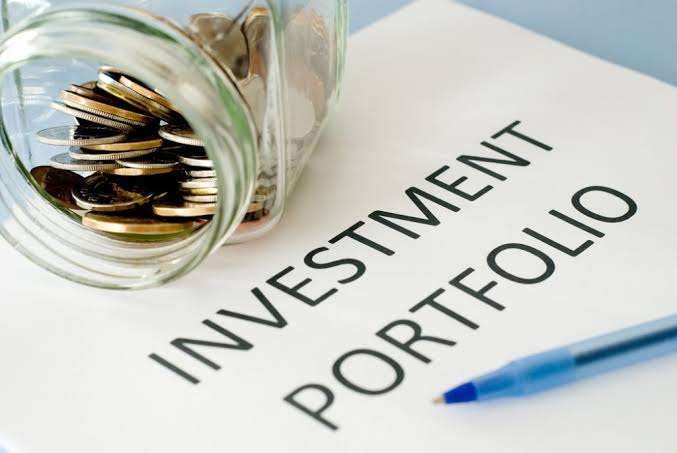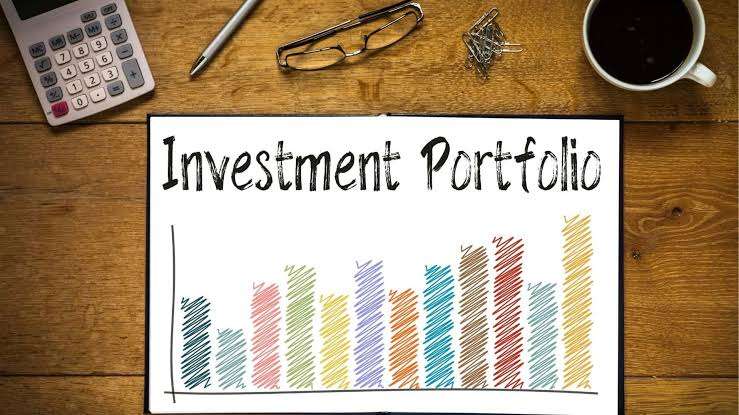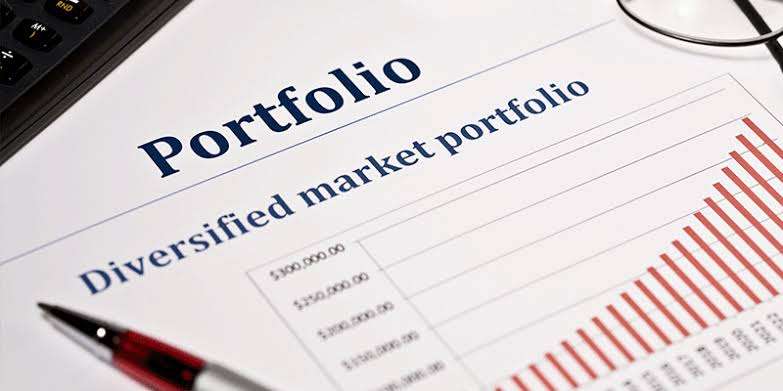Portfolio
How’s it going today guys? Welcome back to the website. So in this Article today, we’re going to be breaking down pretty much everything you’ve ever wanted to know about building an investment portfolio from scratch. Now, this is a topic that some people would call boring because we’re gonna be talking about things like time horizon and risk tolerance but it’s a very important subject and something that people are often not discussing today because when most people are going out there and just buying random stocks, they hear about on Reddit.
They’re not really thinking about building an overall investment portfolio and they probably have no clue or no target allocations in mind. So learning about portfolios and portfolio allocation is really going to give you a leg up on most new investors. Also guys, there’s a lot of information to unpack in this Article. So I highly encourage you to eliminate any distractions around you. Maybe silence that cell phone unless you’re watching on your phone, of course and consider grabbing a pen and a paper for some notes. But that being said, guys let’s jump right into the presentation. Alrighty guys. So let’s get into the presentation here on How to Build an Investment Portfolio, a Step by Step Guide.

So the first thing we have to cover here is a couple of quick disclaimers guys not gonna read the entire thing here but basically I am not a financial advisor. This is not any kind of financial advice and you should always do your own due diligence before investing and this Article is for entertainment purposes only.
What Is An Investment Portfolio?
So first of all guys, let’s talk about what exactly is an investment portfolio. I remember when I was a kid hearing about portfolios and I was always thinking of like an art portfolio and I didn’t understand what that had to do with investments, but anyway, it’s different with investments. An investment portfolio is a collection of different assets. So for example in 2021, a couple of the common assets people invest in are stocks, cash, real estate, as well as crypto gold and plenty of others. More of an idea than a physical object. So your portfolio isn’t like this physical thing you can go pull out of your closet.
Read More >>> What is SEO – Search Engine Optimization | Free Web Design Course
It’s just this general label for all of your investments. Now your portfolio is typically made up of a mix of different accounts, such as your bank accounts, investment accounts, retirement accounts, like a Roth IRA or an employer sponsored 401K. And each portfolio should be created to match your personalized situation. But the most interesting thing in my opinion about portfolios is the fact that it will likely change and it’s going to change over time as your circumstances change. And the issue with that is a lot of people will set up their investment portfolio and then they don’t touch it for the next 30 years, even though you should be periodically making adjustments to those slices within your portfolio which we will talk about later.

So why exactly would somebody invest in the first place? For example, let’s say somebody saying, “Investment seems like a lot of work, I’d rather just stuff cash under my mattress.” Why should I invest? Well, there’s basically two reasons for this. Number one is a big topic right now, and that is inflation. Inflation is constantly eating away at the buying power of your money. And we’re gonna explain what that means in a little bit, not to mention saving your way to retirement is virtually impossible as well.
Let’s say for example you wanted a million dollars for retirement, you would need to save $25,000 every single year for 40 years just to reach $1 million. And by the time you did that, that $1 million would not have nearly as much buying power thanks to inflation. So basically investment is necessary to protect the buying power of your money and allow it to grow over time. And this means you don’t have to save as much money to invest, to have a big impact, thanks to market factors, the biggest one being compound interest.
What Is Inflation?
Now, before we cover compound interest let’s circle back to inflation. Each year inflation causes your money to be worth less. For example, in 2013, a gallon of milk costs only 36 cents. And today that same gallon of milk is nearly $4. Milk did not become scarce or expensive to make and the value of milk simply decreased because you basically are not getting as much for your dollar, less bang for your buck. And historically speaking inflation in the US is at around two to 3% per year. However, there are a lot of concerns of elevated levels of inflation in the years going forward.
So quick inflation example here for you guys, let’s say that today you inherit $1 million from your grandmother and you decide to hold onto the cash rather than invest it. Well, today you can afford to buy a nice house with the money. For example, here’s a property here for $1.1 million. However, 40 years later, that house is likely going to cost about $3 million, if not more and this is solely due to inflation, not necessarily supply and demand. That may come into effect in some way which could cause it to be way more than $3 million. But basically it’s gonna be likely $3 million or more.
So if you would have invested that 1 million, it would be worth far more than $3 million and you’d still be able to buy that house. But if you just left that money sitting there in cash the value is deteriorating. And even though you could have bought a house for a million dollars 40 years later, you’re probably not gonna be able to, I can guarantee you’re not getting that same house for that $1 million.
What Is Compound Interest?
So now let’s talk about this other important factor here called compound interest, or basically the process of interest building on top of interest. So this right here is one of my favorite quotes about compound interest. It says, “Compound interest is the eighth wonder of the world. He who understands earns it, he who doesn’t pays it.” And what I mean by or what this quote basically means here is that if you understand how compound interest works it works for you and it builds your wealth.
If you don’t understand how compound interest works, you basically end up in a lot of debt and you experience compounding debt and it basically hurts you financially for years to follow. So your two ingredients for investing are going to be time and money. And the number one thing you have control over is the amount of time you allow your investments to grow. But you should also be trying to maximize the amount of money that you can invest, especially at early age because that means there’s much more time for that money to grow and for that interest to compound.

So let’s cover an example of this now. Let’s say that today you decide to invest $1,000 at 10% interest. After the first year you will have $1,100 because you earned $100 in interest. However, after the second year you’re going to be earning $110 because you earn 10% interest on the initial $1,000, but you would also earn 10% interest on the $100 of interest you earned in the previous year.
So this affects builds on itself over time like a snowball. For example, in year one it’s just $1,100 by year nine, $2350, year 16, $4,600 and by year 40, that would be $45,250. Based on earning interest on your interest. So that being said, the very first step to building a investment portfolio is determining your goals.
Setting Investment Goals
Always begin with the end in mind. And there’s actual studies out there that show people are way more likely to stick to something like investing or saving, if they have a clear goal in mind. It’s kind of like going to the gym, if you don’t have a goal in mind and your goal is just to show up and do something you may or may not lose weight, but if you had a goal of, “Hey I wanna lose 20 pounds by summer.” You’re way more likely to stick to that gym routine. So I would recommend that you sit down and determine some clear goals.
So most people have a number of different goals surrounding money. For example, it could be retirement, buying a house, planning for a wedding or something like that. So what I want you to do is on a pad of paper or in your notes, make a list of your top three to five financial goals and actually write them out. Now these are going to change over time but what are they right now?
Identify these goals and that is the very first step to building an investment portfolio. So just for example here, you goals could be number one, retire by 60, number two, buy a house in five years and number three, take a Caribbean vacation.
Investment Time Horizon
Now the next thing you wanna consider after setting those goals is your investment time horizon or the amount of time until you will actually need the money. And that’s going to differ based on each of your goals. For example, looking to retire at age 60 gives you a much longer time horizon than looking to buy a house in the next five years. And that’s probably an even longer time horizon than looking to take a vacation somewhere warm.
So based on the time horizon, that’s going to change the type of investment you make and where this fits within your portfolio. And understanding time horizon helps you understand how much risk you can afford to take. For example, it’s going to be less risk if you need the money within a few years, for example you may even just decide to keep it in savings in that case. Whereas you can afford to take more risk, if you have a longer time horizon, for example 10 plus years. It is typically a good idea to plan for each goal independently of the others.
And if you don’t line up your time horizon and your investments, you will likely make choices that are not a great for you basically, because you’re not gonna understand the amount of risk you should be taking. So typically speaking, most people take on too much risk with money, they shouldn’t be risking very infrequently, is it people, taking not enough risk unless that is in some type of like 401k that may not be set up aggressive enough.

So just for an example here of some investment goals and corresponding time horizons, retirement is going to be the furthest one out there for most people. Buying a home is usually a three to five-year process of saving and potentially investing. College planning can be 10, 15, 20 years. Some parents start off when their children are under five years old. A wedding typically takes a couple of years of planning and vacations are usually, a very short term horizon under one year. So it typically doesn’t make sense to invest a vacation savings.
Risk Tolerance
So now let’s talk more about risk tolerance because before you buy anything out there, it’s important to understand the risk of that particular asset and the amount of risk you should take depends on your time horizon as well as your risk tolerance. So for example some lower risk investments out there are cash as well as CDs or certificate of deposit or government bonds. Whereas some higher risk investments would be, individual stocks, REITs or a real estate investment trust or mutual funds. If you are taking on more risk, you should expect a higher return but also more potential downside.
And there are two different types of risk tolerance which are subjective and objective risk tolerance. So basically this describes your internal capacity to take on risk. You should ask yourself the question right here, will seeing your investments drop 20% in a week, make you panic. If so you likely have a lower subjective risk tolerance and this can change over time as your personality changes. So for example, when I first got started in the stock market, if my investment took a 20% drop that would really freak me out and I’d get really upset about that.
But now that I’ve been investing for five plus years, that happens all the time and I literally don’t even stress out about it. So it does change over time. People with lower subjective risk tolerance are more likely to panic sell out of an investment at the wrong time. So if you think you’re one of these people you should not be taking on nearly as much risk as your peers, because you are much more susceptible to making a bad decision of panic selling and locking in that loss. Now the objective risk tolerance is your financial capacity to take on risk.
For example, if an investment drops 20% in a week, will you be in trouble financially? If so you likely have a low objective risk tolerance. And again, this is going to change with your age and your goals because hopefully over time your net worth is growing giving you a greater objective risk tolerance. So if you’re somebody who has a lot of money, you have a greater objective risk tolerance and if you are afraid or you don’t get nervous about your stocks going up and down, you have a great degree of subjective risk tolerance as well. However, most young people are probably lower on the scale of both subjective and objective risk tolerance.

Because if the stocks drop they’re gonna get freaked out, they’re pretty likely to shell with those paper hands and they also probably don’t have a ton of money lying around giving them a lower financial capacity to take on risk. Now it’s important to understand this because many people actually confuse objective and subjective risk tolerance.
For example, a lot of people will justify their panic selling by saying that they need to when in reality it’s purely a subjective or emotional decision. Do you really financially need that money liquidated into cash for bills? Or are you just panic selling saying, “Hey, I need the money.” When in reality, you just prefer to have it in cash sitting in your bank account. It’s very important to understand the difference.
Volatility
So the next term I want to cover here is called volatility. Before you invest your first $1, it is crucial that you understand something called volatility. And this is simply the tendency for an investment to move up and down over time. Volatility gives investors the opportunity to buy low and sell high. And it also can cause investors to panic sell at the wrong time. So if you understand volatility, you can use it to your advantage and you can trade volatility or you can use volatility to add to your position and take advantage of pessimism in the market.
But if you don’t understand volatility, you can get caught up in it and it can take money out of your pocket, if it causes you to panic sell. Before making an investment you should understand the level of volatility surrounding it and in stocks, volatility is measured by the beta. Now this may sound complicated here guys but the level of volatility or beta is simply the tendency of this stock to fluctuate a lot in price. The higher the beta, the more it’s going to fluctuate.
So for example, on the left we have a high volatility stock which is also a high beta stock because the price swings up and down and moves very drastically. On the right though, we have a low volatility stock whereas there’s not nearly as much fluctuation. So for beginners specifically, I always say, look for those lower beta stocks while you’re getting comfortable with experiencing some level of volatility in the market. So once we move past that, it’s now time to begin discussing what type of investor that you are based on your risk tolerance.
And there’s a couple of sub categories between these but the main categories use today are conservative, moderate or aggressive. In reality, this is a spectrum and there’s no concrete box to fall into but generally speaking, younger people tend to be more aggressive and they have more risk tolerance for that. However, if they don’t have a ton of money, they may not have that money sitting there to make these investments or stomach that risk.
Whereas somebody who has been investing for 30 years may have a $2 million portfolio where they have a greater ability to take on that financial risk and it’s not gonna cause them to not be able to pay their bills. Now, one thing I will say here is that people tend to over estimate their level of risk tolerance. So if you think you’re aggressive you might actually be moderate and if you think you’re moderate you might actually be conservative. So just keep that in mind, we tend to overestimate our level of risk tolerance. Also, you don’t have to be just in one field or the other.

It’s possible to be an aggressive investor for some goals, such as retirement and more conservative for other goals like short-term savings for a house and that is totally recommended. You shouldn’t have the same type of assets with the same volatility and risk across your entire portfolio because it’s gonna be different based on the time horizon of each goal. So let’s talk more about conservative investment, okay? The biggest concern is protecting and maintaining wealth. Usually the sole aim here is to keep up with inflation to preserve the buying power of the money and some conservative investors prioritize income investments.
This is typically a good approach for older people or for planning for near term goals. Returns will be very low, but so will the volatility and the downside risk. Generally keeping a larger portion of cash and investing in safer assets like bonds with less overall exposure to the stock market. Now with a moderate portfolio, you’re looking for some growth while keeping some stability. Usually this is going to be a mix of high risk and low risk investment with the aim of outpacing inflation as well as growing wealth.
The time horizon for moderate investments is typically five to 10 years. However, some people will be moderate investors their entire life. With moderate investments, higher expected returns and higher levels of volatility, reducing the amount of cash in favor of more investments. So with a moderate portfolio you’re gonna see less money in cash, less money in bonds and more money in equities or stocks. And then with the aggressive approach the primary goal is to grow wealth over the longterm.
This is somebody who can stomach a higher amount of risk in their investments for higher returns and many young people can afford to be more aggressive investors, as long as they can withdraw their emotions from the equation and not make short term decisions. For example, if you have 40 years until retirement, a 30% correction in the stock market should not be something that you should worry about or cause you to panic sell. If anything, this should be a buying opportunity for you.
Usually with aggressive portfolios, it’s a minimal amount of cash, almost nothing or a very small amount in bonds with the majority of that money in equities and specifically it’s usually growth or emerging markets that have more growth potential. Now the next thing to consider here with your investment portfolio is the level of help or guidance that you are looking for. So basically there’s a number of different ways that you can invest these days and all of them have a different level of service involved.
There is a full spectrum between the do it yourself investor and hiring a full blown financial advisor and many options in between them. And it’s important to take that time to begin to think about, “Hey, what level of guidance am I really going to be needing here?” Now my two cents on this here is this guys, most smaller investors are fine to start out on their own as long as they understand their risk tolerance, as well as their goals and the risks that they’re actually taking on. However, over time as you build up a substantial amount of wealth, it may become a better option to take a more professional approach to ensure you’re doing things as efficiently and effective as possible which may mean using a financial advisor or potentially a robo-advisor option.

But if you’re brand new and just getting started, with a few hundred dollars, for example, you know you probably don’t even have the option of working with in-person financial advisor, but you could use a robo-advisor if you wanted to or you can just do it yourself and learn from the process and revisit later on.
Solo Investing
So first of all let’s talk about solo investing. Many investing apps make it very easy to start out on your own. However, this can be intimidating, if you don’t have any experience. It’s going to require you to spend time researching potential investments and it can be more stressful for a complete beginner looking to get started. However, this is typically the cheapest option because there are countless free investing apps out there today that do not charge any trading commissions. However, this puts you 100% in the driver’s seat, so bear that in mind.
Financial Planner
So the next option on that list here is hiring a full-blown financial planner. If you’re not comfortable going solo, or if you want to work one-on-one with an expert, this may be an option that you consider. However, it is very important that you thoroughly vet anyone beforehand because the bar for calling yourself a financial planner is very low. Generally speaking, you want to look for people with that CFP registered trademark. This means they are legally bound to put your own interests first.
And this group of people have the most rigorous education and experience requirements. You can also pay for an ongoing relationship as a management fee, or you can do an individual engagement with a fee only financial advisor, if you don’t want to pay an ongoing fee to your advisor. And then the option that probably is gonna make more sense for people who are younger is the Robo-Advisor.
Robo Advisor
This is a hybrid option between a financial planner and going solo. And this can help you to increase your confidence that you’re on the right path by giving you some level of guidance. Now, because it is handled by an algorithm and not people, it is less expensive while still carrying many of the same benefits. Essentially, when you get started with most Robo-Advisors including the ones below, they’re gonna ask you a questionnaire to determine your goals, time, horizon, and risk tolerance all of those things we talked about prior.
And then based on that information, it’s going to create a customized portfolio to meet those specific needs. You are typically going to pay a fee, all of these Robo-Advisors charge a fee for the service. However, it’s typically going to be less expensive than your in-person financial advisor. That being said, you do lack the in-person aspect there.
However, betterment does have betterment premium, where they have access to in-person advisors but that’s for accounts with $100,000 or more. So unless you’re willing to pay that premium subscription and you have a ton of money to invest, it’s going to be difficult to get on the phone with somebody to actually discuss your investments.
Account Types
Now, beyond the level of guidance you are looking for, the next thing to talk about with portfolios is the type of accounts you’re looking to open. As mentioned earlier, your investment portfolio is gonna have many different account types because you’re probably going to have retirement accounts bank accounts, tons of different investment accounts. And it’s all going to tie together in this overall portfolio. So most investors don’t think much about the type of accounts they are opening, but depending on your goals there is likely an optimal account for it.

For example, if you’re looking to invest for retirement or college planning there are specific accounts that are gonna be beneficial for that type of investment. So right off the bat, let’s talk about a taxable account which is the most common default investment account. This is the basic account that you’re gonna have with probably Robinhood, Webull or M1 Finance. However, M1 and Webull also offer retirement accounts but the basic one that you open right off the bat is usually the taxable account.
There are absolutely zero tax benefits associated with having a taxable account. The advantage is simply the simplicity in setting one up and the lower minimums. Some of these brokerages have a minimum balance in order to open a retirement account but not necessarily with the taxable account. There are no additional rules or restrictions you need to worry about deposit as much as you want and withdraw whenever you want and you pay taxes on your gains very straight forward.
Now the next account type to talk about here is retirement accounts. So the government wants you to save for your own retirement largely due to the fact of the future of social security and pensions being very uncertain. So they offer incentives for this in the form of tax breaks and tax code, basically incentivizing retirement savings. Now there are going to be limits on how much you are allowed to contribute, but most people if they’re in a position to should be taking full advantage of this, especially with the Roth IRA. Now, first of all, let’s talk about that traditional IRA.
So when IRA stands for an Individual Retirement Account. And this account provides tax benefits if you use it for retirement. You’re allowed to contribute $6,000 per year or if you are 50 or above, you’re allowed to do $7,000 per year. With the traditional IRA, you get to deduct your contribution on your taxes this year but you pay taxes on your gains when you retire. Not able to withdraw until age 59 and a half. And this is best if you’re expect to be in a lower tax bracket in retirement. So basically with the traditional IRA you get that write off now, but you pay taxes later.
So if you think you’re going to make more money now and have a lower tax bracket in retirement this may be a good option. Next up is the Roth IRA, same exact contribution limits. There’s no tax deductions, however, for contributions to a Roth IRA, but you can potentially pay $0 on all of your investment gains. If you do not withdraw the earnings until the age of 59 and a half. The cool thing about a Roth IRA is you are always able to withdraw your contributions anytime. However, it’s important to note that with the Roth IRA, there are going to be taxes and penalties, if you withdraw the earnings early.
Read More >>> Tech gadgets update news and technology information
For example, if you deposit $10,000 into a Roth IRA over two years and it grows to 15,000, you can withdraw your $10,000 contribution at any time tax-free penalty free. However, you have to wait until that retirement age to withdraw that last $5,000 or you’re going to pay taxes and penalties on it. So I liked the Roth IRA because of the potential to pay no taxes on the growth of your money and the fact that you can get access to your contributions if you really need it. Now, when comparing the traditional versus the Roth IRA, here’s a couple of important factors to consider.
Number one, would you rather pay taxes today, or pay taxes later? If you’d rather pay today, then the Roth IRA is for you. If you want to pay later that would be the traditional. Younger people generally lean towards a Roth IRA because they have many, many years ahead for that money to grow potentially tax free. The Roth IRA provides more certainty because you are locking in your tax rate today and tax rates rise drastically in the future where you’re still gonna pay taxes within the traditional IRA. So the cool thing about the Roth IRA is based on the current way, the tax code is written.

You’re locking in your tax rate today and you don’t have to pay taxes tomorrow, if you play by their rules. You’re not allowed however, to contribute to a Roth IRA if your income is too high, however, there are ways to get around this such as a backdoor Roth IRA. Now, there are a couple of other retirement accounts out there such as the SEP IRA and a few others. I’m not gonna cover all of this information but I left it here, if you guys want to pause it and check it out yourself. So there is the SEP IRA, as well as the Self-Directed IRA. The cool thing about this Self-Directed IRA is you get to choose what you invest in. And I do have the Bitcoin logo down there on purpose.
There are ways to invest in Bitcoin through an IRA if you want to. So you can get very creative with what goes in that retirement account, if you’re utilizing a self-directed IRA. Now, the 401k, I do want to discuss here because this does apply to most people. Many jobs will provide you with a retirement investment account known as a 401k. Typically this account has significantly more restrictions and you’re oftentimes limited to a small set of mutual funds. The unfortunate thing about 401ks is that not all of them are created equally and some are much better than others in terms of the portfolios and the fees.
There’s plenty of websites out there. However, that can help you to research your 401k plan and understand whether it’s a good one or maybe it’s a bad one. Now on top of that, there are some tax deductions when you contribute similar to the tax treatment with a traditional IRA and some employers will match your contributions up to a certain percentage. And that’s basically free money. For example, back when I was a nine-to-fiver myself, I worked for a power utility company and they matched my 401k contributions, 50% up to 3%. So if I put 6% of my pay into my 401k, which I did they gave me an additional 3% for free just to support me in making a good financial decision.
So I would recommend if you do have a 401k look into it, determine the quality and also consider reaching out to your HR department to find out, if they have any type of 401K match.
Asset Allocation
Now, the next important thing to talk about here is called asset allocation. With your goals, risk tolerance, and account type now figured out hopefully, you can start to build out your asset allocation or what is actually going to go within your investment portfolio. And your asset allocation basically means the types of investments you’re going to hold in your portfolio. Effective portfolios are made up of many very different assets that do different things at different times. Some of these assets are going to be higher risk, higher return and higher volatility.
For example, individual stocks, mutual funds or REITs. Other assets are going to be lower risk, lower return and lower volatility such as savings accounts, bonds, CDs, and things like that. And all of this together is going to be your asset allocation or your portfolio mix. So the first component to talk about here is stocks. A stock represents ownership in a publicly traded company. Basically, if you own a stock you own a piece of that company. Stocks fluctuate based on company performance as well as supply and demand and overall market factors.
Younger investors typically allocate a higher percentage of their portfolio to the stock market. And this is often also referred to as equities. Now, stocks fluctuate more in the short term but they tend to trend upwards in the longterm giving them more volatility, more risk, but also more potential upside. Buying individual stocks requires significant research and due diligence and many new investors often allocate too much of their money to individual companies and they don’t do nearly enough research. A well diversified stock portfolio typically has 10 to 30 different stocks. However, if you’re doing index funds instead, you could be owning thousands of different stocks.

But if you’re talking specific individual stocks, you know a portfolio of 15 to 30, over the long run is typically what people shoot for. I remember I was talking to somebody one day who was telling me about their portfolio of like 77 stocks. And in my opinion, that’s just ridiculous. That’s way more stocks than anybody could reasonably be able to keep track of. I liked that when a range there of 15 to 30 and that is typically where I fall. Now bonds on the other hand are much lower risk investments than stocks typically used more for wealth preservation not so much growing your money. When you buy a bond, you are essentially loaning out your money.
And if you’re looking for the lowest risk option out there that is going to be US government treasury bonds. Most investors do not actually purchase individual bonds, they get exposure to bonds through a bond fund, like an ETF. This provides diverse exposure to dozens of different bonds. Now, most people out there are investing in stocks and bonds through funds and the fund is essentially a basket of different assets that you can buy into. So typically in funds, you’re gonna see stocks or bonds as well as REITs, which hold real estate. And the benefit of funds is you get instant diversification without as much time spent researching.
Different funds will have different specialties or focuses. For example, you could find total stock market index tracking funds versus sector specific funds like semi-conductors and you can also find target date funds that are going to adjust their allocations over time to basically change the risk as you approach that target date for retirement. You can essentially find an entire portfolio already prebuilt and ready for you in the form of an investment fund, which is super convenient. However, most funds will charge a fee in order to invest with them. So there’s a huge advantage to not having to build a whole portfolio yourself but you do pay for it in the form of a management fee, in most cases.
Now, when you’re looking at funds it’s important to understand whether or not you’re looking at a passive or actively managed fund. Some funds are passively managed while others have an active manager and actively managed funds are more expensive. The primary cost you are paying with funds is called the expense ratio. And if you simply Google the name of the fund it’ll give you that ratio. For example, on the right there we have a Vanguard Total Stock Market Index Fund, with an expense ratio of 0.04%, which is very low. On the other hand, actively managed funds can have expense ratios even above 1%, which can be crazy, especially if these funds are not beating the overall returns of the stock market.
So over the years these actively managed mutual funds have become less and less popular. And one of my thoughts there guys, rather than paying for active management with lackluster performance potentially most people are better off with index funds over mutual funds. And I’m certainly not the first person or the only person that has said that. And this is pretty sad here too guys, this right here is the number of actively managed funds that underperformed the market or didn’t perform as well as just the S&P 500, okay. And that is pretty outstanding. Over time 95% of actively managed funds tend to underperform the market. So a passive approach is almost always the right way to go.
So now let’s discuss stocks versus funds. Individual stocks have the potential for higher growth because funds are less concentrated which lowers overall volatility. Now, most people think they are far better at picking stocks than they are which is unfortunately the reason for that slide we just saw where lots of the professional money managers can’t even beat the market and the same as typically the case for the retail trader. Now many ETFs have low expenses and consistent returns and stocks and ETFs trade during the day while mutual funds do not. Mutual funds settle prices at the end of the day, which is one of the interesting caveats not to mention mutual funds are less tax efficient because they are making a lot of trades which typically comes at a cost.
So basically many investors will choose to hold a mix of individual stocks and funds within their investment portfolio. You don’t have to be totally one side or the other. For example, I own index funds in my portfolio and I own a lot of individual stocks and they do different things for me based on those different goals.
Real Estate
Now, the next asset I wanna to cover here which is also a big part of my portfolio is real estate. So real estate is one of the most popular non-stock investments out there and it is the largest asset in most American’s portfolio because of their single family home. Investors purchase investment properties for three main reasons. Number one, cash flow from the property, number two, appreciation or an increase in the value and number three, the tax benefits associated with real estate investing. Unlike the stock market, you can invest your sweat equity into real estate and you can take advantage of something called leverage.
So with real estate, you can generate returns by repairing and upgrading the property, you can’t upgrade or repair stocks or bonds and you also can’t live inside of them. So those are a few of those advantages of owning real estate. Also a lot of tax benefits, and it’s a great hedge against inflation that is not highly correlated to the overall stock market. So with real estate you have a number of different options for getting exposure. You have direct investment, you have real estate investment trusts, you have real estate mutual funds and crowdfunding. I personally only utilize two of those options which is direct investment and real estate crowdfunding via fund rise.

Investors decide how actively they want to be involved and correspondingly you pick your investment avenue. Many crowdfunding platforms and REITs have minimums under $1,000 making it a significantly easier way to get exposure versus direct investment, which could cost you tens of thousands, if not hundreds of thousands of dollars for a huge down payment on that property. So for most people, the easiest and most accessible way to get exposure to real estate is going to be through REITs or real estate mutual funds or crowdfunded real estate.
Crypto currency
So the next one to cover here is a new one and that is cryptocurrency, which is becoming a larger and larger component of people’s portfolios. Right now over 21 million Americans own cryptocurrency which is around 14% of the population. The primary use case for Bitcoin is a store of value and this is similar to basically a digital gold and Bitcoin could be an effective hedge against inflation but right now it’s just still way too volatile but it is part of my investment portfolio and it is for a lot of people too.
Other cryptos have use cases and utility values as well, totally depends on the project. And a lot of experts these days are recommending you have anywhere from 0.5% to 2% of your total portfolio within cryptocurrency. And right now I have about two to 3% of my total portfolio in cryptocurrency. So I’m actually following this myself too. Now what you’re ultimately trying to do here is to create a mix of different assets that are gonna do different things at different times.
So essentially, you’re looking to create an effective mix of assets, just like we’re seeing down here because they’re all going to behave differently and hopefully smooth each other out. For example, let’s say you had a ton of money in the stock market, right? And the stock market took a nosedive, but on the other hand you had a bunch of gold in your portfolio that actually went up in value. The gains from the gold could offset the losses in the stock market and that’s exactly what you’re looking for from a durable investment portfolio that is properly allocated.
Portfolio Examples
So now that we have definitions on conservative, moderate and aggressive, let’s take a look at what some of these portfolios might visually consist of. So first of all, looking at this conservative portfolio here it has 15% cash, 10% real estate, 25% corporate bonds, 25% government bonds and 75% in stocks.
So overall this portfolio has half of this money in bonds, 25% in equities, 10% in real estate and 15% in cash since bonds are the primary component, this is a very conservative portfolio that should experience less volatility, less risk and lower returns but should be better for preservation of capital.
Moving on, here’s an example of a more moderate portfolio. We see 1.5% crypto allocation, 5% cash, 30% corporate bonds, which are higher risk than treasuries for example, then we have 10% real estate and then as far as the stocks specifically, we’re looking at a small cap fund, which are smaller growing companies a large cap fund, as well as foreign investment for global market diversification.
So in this particular investment, they have 30% in bonds. They have a total of, it looks like a 53.5% in equities, 10% in real estate, 5% cash, 1.5% crypto. So a lot less in bonds, a lot more in stocks, less cash. And a dash of crypto makes this a more moderate portfolio. And then taking a look at an aggressive portfolio mix here.
We see 2% crypto, no cash to speak of, 10% corporate bonds, 10% real estate, 20% foreign, 13% small cap, 15% mid cap and 30% large cap stocks. So in total, that’s just 20% of that portfolio being allocated to real estate and corporate bonds or bonds in general, 50, 50, 2% crypto, nothing in cash and the remaining which looks like about 78% in equities. Now, that being said, guys here’s a few key points to remember. Your situation depends on your goals, your risk tolerance and your time horizon, which now you have a good understanding of all of these things and you should be able to identify them.
These portfolios we just covered are meant to be just general guidelines, not specific examples for any one person to follow. The goal is to balance your risk level and your returns and get to a point where you find a combination that you’re comfortable with. Basically, you’re happy with your returns and on the bad days or the bad months, you’re not totally stressed out about the losses that you’re experiencing.
It will likely be much easier to start with funds and then branch out to individual stocks over time, which is typically what I recommend for beginners, and when looking for funds out there Vanguard offers some of the lowest fee options.
And I’ll go ahead and toss a article up in the corner about the best Vanguard Index Funds for beginners. If you want to check that out at the end. So now let’s talk specifically about choosing investments for your portfolio. So the investments that you select on day one might not be the same investments you wanna be holding in 10 years. So it’s important to understand that number one, you should take a lot of time to figure out your initial investments and where you wanna have your money based on your goals and your risk tolerance and your time horizon.
But it’s also important to understand that that is going to change over time. And most experts recommend changing the portfolio mix at least every five years. Not to mention as your goals and circumstances change, you should check into your overall portfolio to make sure you’re still on track. For example, let’s say you got a huge promotion at work and now you can funnel a lot more money into investments.
Maybe now you want to be more aggressive with some of that money, or it could be a totally different circumstance where you lost some of the income from your job or something and now you want to be more conservative or potentially utilize some of your portfolio to live off of that money.

It’s gonna be totally different and it’s gonna change all the time. So just understand that, building a portfolio is not a one-step process and it’s something that you’re going to likely be adjusting every five years at minimum. But also on the other side of the token, you don’t want to be adjusting your portfolio every single month because that’s just going to generate a frenzy of activity possibly trading commissions and short-term capital gains potentially.
So we’re not gonna get into taxes in this video, we covered a lot of that in my in-depth stock market for beginners video, which I’ll also put in the corner but understand that you don’t wanna change it too much but you also don’t want to leave it alone for 10 years and do nothing with it.
How To Pick Stocks
So talking about individual stocks, how do you pick stocks for your portfolio? There’s a lot that goes into this guys but I’ll give you a few basic things here. The two most common ways people pick stocks are through fundamental or technical stock analysis, whereas fundamental analysis looks at the financial statements and health of the company overall. So they’re looking at things like revenue, profitability, debt levels, growth, whereas technical analysis is solely looking at the chart patterns used for short term trading.
So most people are gonna fall in one basket or the other. Are they looking to trade short term moves based on the charts, or are they looking to do their own fundamental research on companies, learn how to read the balance sheet things like that and make their own decisions based on their own due diligence. That’s more of a fundamental investor versus a technical trader. So just a few things that I look for when picking stocks. I always analyze that balance sheet, I look at their assets versus liabilities.
How much cash do they have? I look at the types of debts they have. Is it mostly short-term versus long-term debt? I’m also gonna look at that PE ratio to compare the valuation to their competitors. As far as another tool I use, I recommend a free app out there called front.org. I’ll also toss a link in the description. This gives you a free FISCO score which is similar to your credit score on a stock just to give you an we’ll report on them looking at multiple different things factors.
I also like looking at the Moat that accompany might have or what is the clear competitive advantage, isolating them from their competition. I also look at the overall sector growth, is the business segment that they’re involved with growing or shrinking? Is there any regulatory pressure? What is the political environment surrounding that sector or industry? And then I also look at public sentiment. How does the public view this company? Those are all factors I consider when doing individual stock research.
How To Pick Funds
Now, when it comes down to picking funds that process is going to be a bit different. And it’s largely going to depend on if you’re looking for passive or active management, I’m assuming most people are looking for passive because we just showed you how most active fund managers are more expensive and they don’t even successfully beat the market. So most people are going to be looking for passive funds. With passive funds, you’re going to be looking at things like low fees and low tracking error to make sure it’s matching up with the underlying index as closely as possible.
With active funds, you’re gonna be looking at positive risk adjusted returns and understanding is the fund manager outperforming the index. But with funds, you know, the passive ones the main things to consider are the asset mix as well as the fees and I of course, highly recommend Vanguard products guys. I’m not paid to say that or anything, they just have some of the best financial products on the market with some of the lowest fees.
How To Pick Cryptos
Now, when it comes to picking cryptocurrencies guys, this is a total crap shoot, to be honest with you in 2021 because there’s over 10,000 altcoins with new ones coming to market every single day. If you want my opinion on it guys, I would stick to pretty much whatever the top 10 coins are in terms of market cap, because it’s very difficult to tell what is a legitimate coin from a scam out there.
And, and most people are just sticking to the big names out there like Bitcoin, maybe Ethereum, potentially Dogecoin, depending on if it continues to have value over time, but just be careful of a lot of the scams out there guys, and the altcoins or trying to get on the next big wave, and trying to get in on, the next Dogecoin, for example. That’s where you wanna be more careful for long-term investment, I personally like Bitcoin, as well as Ethereum and I hold some Matic as well. So that’s what I personally like.
But you guys have to do your own due diligence and research on cryptos. Also guys, the more educated you are on what you own, the less likely you’re going to be for panic selling. So that is why I encourage you to involve yourself and learn as much as possible about cryptos or individual stocks that you decide to add to your portfolio. So now let’s talk about the fun part, which is how much money are you hopefully going to make from your investment portfolio?

Well, the truth is nobody’s going to know for sure, based on the things you choose to invest in, but what I can help you to answer instead is this question of how much do I need to contribute to reach my goals? And I’m gonna show you how to do that using a free compound interest calculator. So this one right here is on the. gov website that I highly recommend. And so this is what you’re gonna do.
At the very top, you’re gonna enter the amount of cash you are starting out with in your portfolio and then under step number two, the amount you think you could reasonably add every single month and then the time horizon on your goal. And then at the bottom, the estimated rate of return associated with your portfolio asset allocation and conservatively speaking, a lot of people use 8%. You take 10%, you subtract 2% for inflation.
So if you expect an 8% return, over the long run through a good mixed portfolio, that could be a reasonable figure to put there. So for this specific case here, we did a $1,000 initial investment a $500 monthly contribution, and a 40 year time horizon at an 8% interest or a rate of return and that surprisingly, over 40 years would give us over $1.5 million. So you can play around with these numbers and you can change your monthly allocation or the number of years you invest for. And this is gonna give you an idea of what you can accomplish over the long run with a well diversified investment portfolio.
And obviously guys, if the number that you’re looking at is not one that you’re happy with, you either have to invest for more time or add more money. The only real factors you have control over is the time the money, and then what you invest in. So this covers the asset mix and what you should consider investing in, the only things you really have control over is the time which depends on your goals.
And then the amount of money you can invest, which depends on the amount of sacrifice you’re willing to make in your own life towards a better future. So if you’re happy with that number, keep doing what you’re doing and if you’re not happy with it, you know you may have to make more sacrifices to allow yourself to contribute more money every single month.
Dollar Cost Averaging
Now, one other thing I want to cover here with you guys is an important strategy known as dollar cost averaging, which is one of my favorite strategies to follow when investing in the stock market. Essentially, by contributing to your portfolio on a regular basis you can practice dollar cost averaging, which ensures that you don’t just buy in at the top. So for an example here, this is somebody contributing a consistent $300 per month into a stock, and when the stock is higher, you buy less.
And when it’s on sale, you’re buying more. So for example, when the stock is 30 bucks a share, you’re only able to buy 10 shares but if it fell down to 10, you’re able to buy 30 shares. And if it goes up to 20, you’re able to buy 15. So if you invest the same amount of money every single month or every single week you’re paying the market average over time and you’re reducing the likelihood of buying at the top of the market. So for long-term, investing dollar cost averaging is one of my favorite strategies to follow.
Also guys, just a few other pointers here for you just from my own personal experience. First of all, consistency is the most important factor pretty much when you’re doing this, because if you’re not consistent and you don’t consistently put money away, there’s not really much money going in there. And so then all you have is that amount of time that you’re leaving your money to grow. You need time and you need consistent contribution of money. Those are your two ingredients there for compound interest.

Most people will try to reach these unattainable goals by taking on excessive amount of risk. So let’s say you’re 50 years old and you have no money for retirement. So you’re saying, “Hey let me go put a bunch of money in penny stocks. So I’m can hopefully triple my money.” Not a good idea. Very, very rarely is there ever a good outcome with something like that? The best option for most people is to make more money or spend less, which could allow them to contribute more towards investment or, meaning they don’t have to withdraw as much from their savings and retirement when they actually need it.
Rebalancing
Also, guys, rebalancing is very important because over time your portfolio will drift from the allocation that you initially set up for it. And rebalancing is the process of bringing it back to the initial allocation, you set up for it. As I mentioned earlier guys, this is something a lot of people totally forget about. Most experts recommend doing this at least every five years if not much more frequently. And then another rule of thumb that people tend to follow is if your target allocation drifts more than 5% that might be a good indicator that it’s time to rebalance.
However, always consider the tax consequences associated with a portfolio rebalance. So robo-advisors and financial planners will do this rebalancing for you but if you’re investing solo and it’s going to be on you to manually rebalance. Most people either be balanced quarterly or annually. Some people do it every five years and then a lot of people don’t even do it at all, which could mean that you’re taking on too much risk or not enough risk and costing yourself in returns.
To rebalance you simply buy what you are underweight in and that could mean putting new money in or selling what you’re overweight in to buy what you’re underweight in, which forces yourself to buy low and sell high. But also around the time of rebalancing maybe your allocation percentages may change as well. So always consider your allocations before rebalancing and if those may need to change as well based on how close you are to those individual goals and your overall time horizon.
So for an example here of a rebalance, let’s say Jo has a portfolio of 70% stocks and 30% bonds, but after six months the stocks performed really well and they now make up 90% of his portfolio and stocks are only 10%. So what he could do is buy more bonds with cash, he could sell some stocks or just do a mixture of both to return his portfolio back to that 70/30 stock versus bond allocation. And this ensures their portfolio still matches their situation because a 70/30 stock to bond portfolio is less risky than a 90/10.
So in this case, even though we started off at that target allocation, this portfolio became much more aggressive and it had to be dialed back to maintain that same risk level. And then lastly guys, just a few pointers to leave you with here. Most investors begin without the end in mind. And if you ask your average retail investor out there, “Hey, what are your goals for your investments?” They’re going to give you a blank stare. They don’t know what their goals are.

They don’t know what type of investor they are. They’re typically getting caught up in the next hot stock opportunity, maybe on Reddit. And they’re typically doing a lot of trading and oftentimes not very successfully. Investing is a marathon and not a sprint. Short-term investing is speculating largely relying on luck. Successful investors are in it for the long run. I’m not saying I don’t speculate from time to time guys, I definitely do but the majority of my money is in long-term marathon type investments.
Warren Buffett’s quote right there as well guys explains this well. “Risk comes from not knowing what you’re doing.” So the more you research potential stocks, cryptos, real estate funds, et cetera, the more you know, the less risk because you have more knowledge about that topic. Successful investors make a plan, have confidence in the plan, and then they stick to the plan. If you enjoyed this Article please drop a like and consider sharing it with a friend. Leave me a comment down below if you had any thoughts or feelings on the Article and as always, I hope to see you next time.

Wow
very interesting
Thanks for your work